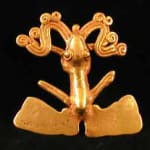Gold Pendant of a Frog, 11th Century CE - 16th Century CE
Gold
2
FJ.6212
Further images
Frogs appear frequently in the goldwork of Pre-Columbian Costa Rica, a tropical region in which numerous species of small frogs exist. Both tree frogs, which range in length from an...
Frogs appear frequently in the goldwork of Pre-Columbian Costa Rica, a tropical region in which numerous species of small frogs exist. Both tree frogs, which range in length from an inch to “giants” of five inches, and terrestrial frogs of small size and poisonous skin are known. The frogs are often vibrantly colored; bright yellow and “gold colored” frogs are among them. It is possible that this pendant is a stylized representation of a tree frog; tree frogs have extremely long legs, like those seen projecting from the body of this sculptural pendant, and equally long feet, here reduced to flattened rectangles. The frog is sitting, and ethnographic evidence suggests that this posture is significant for amphibian imagery; however, this significance remains a mystery. Emerging from the mouth of the frog, two snakes (or perhaps a bicephalous serpent) wind their way outward, appearing almost like a moustache. The meaning of this pairing, unfortunately, remains as mysterious as the importance of the seated posture. The frogs front two feet loop around into a pair hooks, allowing the work to be publicly displayed on a necklace and worn for ceremonies or festivals. Due to our limited comprehension of the rich mythological traditions of the Pre-Columbian Costa Ricans, the full meaning of this masterpiece remains clouded. Although we may never completely understand the cultural and religious importance of this work, we can revel in its outstanding beauty and skilled artistry.





